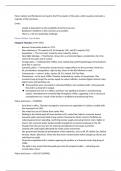Party, Cabinet and Parliament are loyal to the PM as leader of the party, which usually commands a
majority of the Commons.
Limits:
- Loyalty is dependent on the possibility of electoral success.
- Backbench rebellions in the Commons are possible.
- There is a risk of a leadership challenge.
Prime Minister Case Studies
Margaret Thatcher (1979-1991)
- Became Conservative leader in 1975.
- Won elections in 79 (majority 43), 83 (majority 144), and 87 (majority 102).
- Reputation -> ‘The Iron Lady’, loved by some, hated by others.
- New Right Ideology -> Thatcherism, shows her as a historical figure, presidential, she’s the
centre of her party and in control.
- Foreign policy -> Falklands War (1982), close relationship with Ronald Reagan (US president),
hard-line in cold war.
- Economic policy -> monetarism (controversial, ranged effects on the economy), North Sea
oil, privatisation, deregulation, right-to-buy, boom in the 80s followed a crash.
- Controversies -> miners’ strike, Section 28, EU, Ireland, Poll Tax Riots.
- Monetarism = in the early 1980s, Thatcher embarked on a policy of monetarism. This
involved trying to target the money supply to reduce inflation. Involved higher interest rates,
higher taxes and spending cuts.
These policies were successful in reducing inflation, but combined with a strong pound,
they led to a deep fall in output.
Unemployment rose to 3 million and there was significant decline in manufacturing
output. Unemployment remained high throughout 1980s, suggesting a rise in structural
unemployment as a result of the decline in traditional manufacturing firms.
Policy and Events -> CONTROL
- Early time in office, Thatcher managed to overcome any opposition in Cabinet, notably with
the monetarist of 1981.
- She made less use of Cabinet than earlier PMs.
- Sticking to her beliefs paid off (won election in 82, united the Cabinet, economic boom).
- Economic policy demonstrated strong control. Monetarism (strict control of inflation by
reducing government spending, restricting money supply and using interest rates- higher or
lower). Her economic policy fundamentally changed the economic landscape in the UK.
- Change from the post war aim of reducing unemployment (no longer a priority).
- Clashed with (and largely defeated) the trade unions movement.
- Her government introduced privatization of key industries, such as BP, BT, British Gas, British
Airways, Water, Electricity. Many who had never owned shares before bought up shares and
sold them for profit.
- Financial reregulation led to London regaining its position as a financial centre (big bang of
1986).
- The right to buy meant that thousands got onto the property ladder -> attracting new
Conservative voters.
Policy and Events -> LACK OF CONTROL





